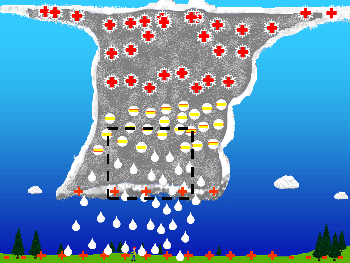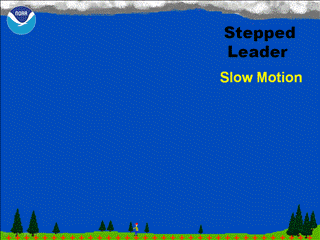Stepped leaders develop within thunderstorm clouds when charge differences between the main region of negative charge in the middle of the thunderstorm and the small region of positive charge near the base of the storm become large (Figure 1).
Stepped leaders start to develop when charge differences in the cloud become too large. When this happens, the insulating capacity of the air breaks down and the negative charge starts moving downward (Figure 2).
Typically, the small amount of positive charge at the base of the cloud near the developing channel is not sufficient to satisfy the negative charge that has accumulated along the conductive channel aloft. Consequently, the negatively charged channel emerges from the bottom of the cloud and continues to move toward the ground (Figure 3).
It is worth noting that the tip of the stepped leader does not sense the actual charges on the ground as it emerges from the cloud. Rather, as it moves out of the cloud, the stepped leader only senses charges within about 50 meters of the leader tip. As a result, the stepped leader and surges ahead in 50 meter segments based solely on the charges in the air immediate surrounding the tip (Figure 4). Each surge of the leader produces a small flash of light which can be detected by high speed cameras.
As a result, the path of the leader from cloud to ground can be very jagged and indirect, Figure 4. Consequently, the leader does not take the path of least resistance from cloud to ground as it moves blindly toward the ground. In addition, the stepped leader generally branches outward as it seeks a connection to the ground.
Depending on the electric field surrounding the step leader, individual branches of the leader may become more or less prominent, Figure 5.
While the stepped leader develops downward at a speed of 200,000 miles per hour, the leader would move much faster if it didn't pause between each of its steps downward.
Learn about Making a Connection with the Ground or return to Contents page
 Figure 2 |
 Figure 2 |
 Figure 3 |
 Figure 4 |
 Figure 5 |